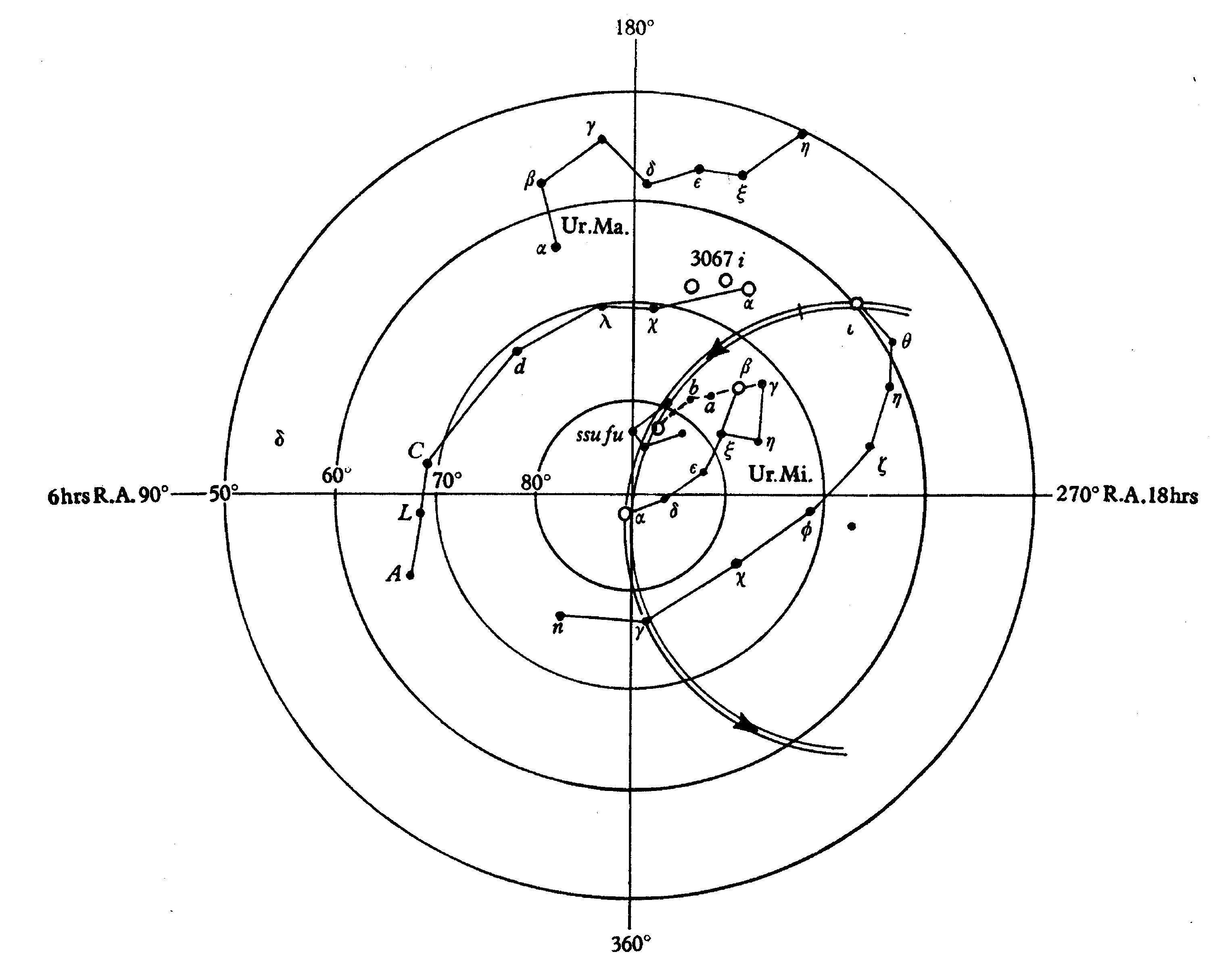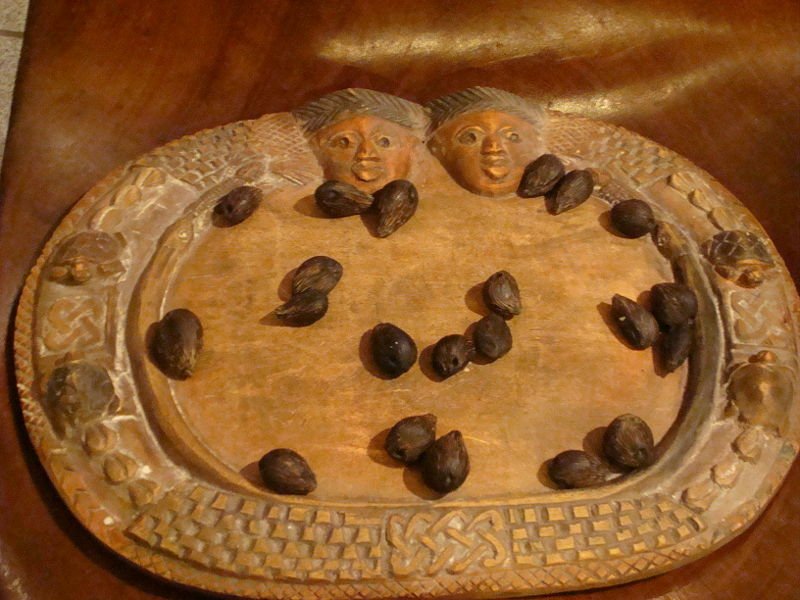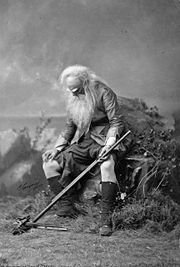|
TRANSLATIONS
Next page in the
glyph
dictionary:
|
5.
A road like the Milky Way should lead somewhere. Presumably the road
for the wandering souls leads to
the abode of the dead,
or to 'nirvana'. The Chinese regarded the northern cap of the sky as
the most important part, where the 'Emperor' ruled - at the pole, which was steady as a rock. The Emperor's abode was defined by two
'walls' or chains of
stars:

The north pole slowly moved in a circle ... inside these walls
of Ming Thang, The Bright Palace, 'the mystical
temple-dwelling which the emperor was supposed to frequent, carrying
out the rites appropriate to the seasons'. (Ref.: Needham 3)
Likewise, the ancient Egyptians regarded the region around the north
pole as special:
"... The ancient
Egyptians observed the stars and the circumpolar stars they regarded
as qualitatively different from the ordinary stars which arrived at
the eastern horizon and later disappeard behind the western horizon.
The circumpolar stars had a
circular motion, whereas the ordinary ones went straight across the
sky ..." (Lockyer)
In a palace with walls like cobras Osiris
resided:
"...
In the Book
of the Dead we are ... told that Osiris, as 'Lord of the Duat',
resides in a palace whose walls are 'living cobras' ..." (Hancock 3)
According to a Japanese legend a fisherman named
Urashima visited the Land-of-Spirits
where time slowed down. |
The 'cobras' hyperlink leads to:
|
A board game mentioned in Wikipedia is the Yoruba divination game
named Ifá, where instead of cowries palm nuts are used:

... The tray and tapper
are used in Ifa divination, a central
ritual within Yoruba religion. This
tray, adorned with carved images and
dusted with powder, serves as the
template on which sacred signs (odu)
related to the personal concerns of a
diviner's client are traced as the point
of departure for analysis. In contrast
to those transitory signs, the more
permanent backdrop of the carved motifs
on the tapper and tray constitutes an
artistic exegesis of the forces that
shape human experience and the universal
needs fulfilled by such quests for
enlightenment.
To initiate the ritual, the babalawo
places the tray in front of him and taps
rhythmically on it with the pointed end
of the tapper, invoking the presence of
past diviners and of Ifa (also called
Orun-mila) the god of divination as
well as other Orisa.
There are a variety of
palm nuts that are available, but only
specific kinds may be used for Ifa
divination and must have at least 3
'eyes' or more. The palm nuts are
grouped in one hand, then the diviner
attempts to shift them all to his/her
other hand at once, and counts the
remaining Ikin left, hopefully to
discover that either one or two remain.
(Odu, which are the foundation of the
binary data, can only be marked with
either one or two palm nuts, remaining
in the diviner's original hand. As this
process goes on, the diviner marks
single or double marks in wood powder
spread on his divination tray until he
or she has created one of the 256
odus that are available.
Each of these odus
is associated with a traditional set of
Ese (verses), often relating to Yoruba
mythology, which explain their
divinatory meaning. These verses
represent thousands of years of
observation and are filled with
predictions, and both mundane and
spiritual prescriptions that resolve
issues found in that Odu. Within Ifa,
Believers find all the knowledge of the
world past present and future.
After obtaining the
Odu that governs a situation or event,
the diviner then determines whether the
Odu comes with Ire (which is poorly
translated to mean good luck) or Ibi
(which could be viewed as obstacles or
impediments to success). After this
process the diviner now determined
appropriate offerings, spiritual
disclipines and/or behavioral changes
necessary to bring, keep or compel
success for the person receiving
divinatory counsel ... (Wikipedia)
|
The tray depicted has 4 turtles engraved on the border, and at
the 'takurua position' (top center) we find two 'persons'.
The central plane is delineated by 2 serpents (or rather one serpent
with two heads).
In Norse mythology too, the border line was defined by a snake:
"Jörmungandr
['jrmuŋgandr], alternately referred to as the Midgard Serpent
or World Serpent, is a sea serpent of the Norse mythology,
the middle child of the giantess Angrboða and the god Loki.
According to the
Prose Edda, Odin took Loki's three children, Fenrisúlfr, Hel
and Jörmungandr. He tossed Jörmungandr into the great ocean that
encircles Midgard. The serpent grew so big that he was able to
surround the Earth and grasp his own tail, and as a result he earned
the alternate name of the Midgard Serpent or World Serpent ..."
(Wikipedia) |
And the
Urashima
link to:
|
"... we read of a fisherman later
revered as a deity named Urashima:
He was hadsome of
feature ... He went out alone in a boat to fish with hook and line.
During three days and nights he caught nothing, but at length he
caught a turtle of five colours. Wondering, he put it in the boat ...
While he slept the turtle suddenly became transformed into a woman,
in form beautiful beyond description ...
He said to her, 'This
place is far from the homes of people, of whom there are few on the
sea. How did you so suddenly come here?'
Smiling she replied, 'I
deemed you a man of parts alone on the sea, lacking anyone with whom
to converse, so I came here by wind and cloud.'
She is, of course, a Kami
[a spirit],
as he quickly understands, from a magical land that 'lasts as long
as sky and earth and ends with sun and moon'. And she tempts him:
'You can come to that
region by a turn of your oar. Obey me and shut your eyes.'
So presently they came
to a broad island in the wide sea, which was covered with jewels.
(On it was a great mansion.) Its high gate and towers shone with a
brilliance which his eyes had never beheld and his ears had never
heard tell.
They enter the mansion and are
received and greeted in a loving fashion by her parents: 'Seated
they conversed of the difference between mankind and the
Land-of-Spirits, and the joy of man and Kami meeting.
Eventually the fisherman
Urashima and the beautiful sea Kami are married.
Thereafter: 'For three years, far from his aged parents, he lived
his life in the Spirit capital, when he began to yearn for his home
and for them.' Observing the change in him, his wife asks: 'Do you
desire to return home?'
He replies: 'To come to this
far Spirit Land, I parted from my near and kin. My yearning I cannot
help ... I wish to return to my native place to see my parents for a
while'. Then we read:
Hand in hand they
walked conversing ... till they came to where their ways diverged and
where her parents and relatives, sorrowing to part with him, made
their farewells.
The princess informed
him that she was indeed the turtle which he had taken in his boat,
and she took a jewel-casket and gave it to him saying: 'If you do
not forget me and desire to seek me, keep this casket carefully, but
do not open it.'
Thus he parted from her
and entered his boat, shutting his eyes as she bade him.
In a trice Urashima
finds himself back in his home village again but a terrible surprise
awaits him. During the three years that he has spent enchanted on
the Spirit island 300 mortal years have passed and everything has
changed beyond recognition.
Stumbling around dazed and
disconsolate, discovering from a passer-by that his own
disappearance three centuries previously is itself now the subject
of a village legend, he forgets the warning about the jewel box and
opens it to remind himself of his Kami wife: 'But before he
could look into it, something in the form of a blue-orchid soared up
to the blue sky with the wind and clouds. Then he knew that, having
broken his oath, he could not go back and see her again."
(Hancock 2) |
And, lastly, the
3rd link about
slow time to:
|
Near the poles time seems to slow down. Not only does the sun at
solstice seem to stand still, but the center of the revolving sky
dome must logically be a point where the motion practically will be
nil. Time is measured by the revolving Great Bear (in the north)
or by the revolving Crux (in the south). Therefore the poles seem to
measure out time, to be the origin of time. Allen:
"...
Whittier said, in his Cry of a Lost Soul: 'The Cross of
pardon lights the tropic skies'; which is correct for our day, as it
is not now entirely visible above 27º 30' of north latitude. It was
last seen on the horizon of Jerusalem - 31º 46' 45'' - about the
time that Christ was crucified. But 3000 years previously all its
stars were 7º above the horizon of the savages along the shores of
the Baltic Sea, in latitude 52º 30' ...
Von Humboldt adds: The
two great stars, which marks the summit and the foot of the Cross,
having nearly the same right ascension, it follows that the
constellation is almost perpendicular at the moment when it passes
the meridian. This circumstance is known to the people of every
nation situated beyond the Tropics or in the southern hemisphere.
It has been observed at
what hour of the night, in different seasons, the Cross is erect or
inclined.
It is a time piece,
which advances very regularly nearly four minutes a day, and no
other group of stars affords to the naked eye an observation of time
so easily made.
How often have we heard
our guides exclaim in the savannahs of Venezuela and in the desert
extending from Lima to Truxillo, 'Midnight is past, the Cross begins
to bend' ...
Crux lies in the Milky
Way, - here a brilliant but narrow stream three or four degrees
wide, - and is noticeable from its compression as well as its form,
being only 6º in extent
from north to
south, and less in width, the upper star a clear orange in color,
and the rest white; the general effect being that of a badly made
kite, rather than a cross ..."
Posnansky:

"...
Schematic drawing of the 'socle of the central figure of the Sun
Door' on which can be seen the 'eyes' with 'Star' signs on the
coronas and the 'ring nose' as in the position of the constellation
Southern Cross at nightfall at the solstices ..."
The mystery of time is a major theme of the world myths.
Wikipedia:
"... The story of Rip
Van Winkle is set in the years before and after the American
Revolutionary War. Rip Van Winkle, a villager of Dutch descent,
lives in a nice village at the foot of New York's Catskill
Mountains. An amiable man whose home and farm suffer from his lazy
neglect, he is loved by all but his wife. One autumn day he escapes
his nagging wife by wandering up the mountains.
After encountering
strangely dressed men, rumored to be the ghosts of Henry Hudson's
crew, who are playing nine-pins, and after drinking some of their
liquor, he settles down under a shady tree and falls asleep. He
wakes up twenty years later and returns to his village.

He finds out that his
wife is dead and his close friends have died in a war or gone
somewhere else. He immediately gets into trouble when he hails
himself a loyal subject of King George III, not knowing that in the
meantime the American Revolution has taken place. An old local
recognizes him, however, and Rip's now grown daughter eventually
puts him up ..."
"... The
story is a close adaptation of Peter Klaus the
Goatherd by J.C.C. Nachtigal, which is a shorter
story set in a German village.
The
story is also similar to the ancient Jewish story
about Honi M'agel who falls asleep after
asking a man why he is planting a carob tree
which traditionally takes 70 years to mature, making
it virtually impossible to ever benefit from the
tree's fruit. After this exchange, he falls asleep
on the ground and is miraculously covered by a rock
and remains out of sight for 70 years. When he
awakens, he finds a fully mature tree and that he
has a grandson. When nobody believes that he is
Honi, he prays to God and God takes him from
this world. Note also that the family name of
Honi is also a term of geometry ('M'agel'
is Hebrew for 'circle maker'), as well as the family
name of Rip ('Winkel' is German for 'angle').
The
story is also similar to a 3rd century AD Chinese
tale of Ranka, as retold in Lionel Giles in
A Gallery of Chinese
Immortals.
In
Orkney there is a similar and ancient folklore tale
linked to the Burial mound of Salt Knowe adjacent to
the Ring of Brodgar. A drunken fiddler on his way
home hears music from the mound. He finds a way in
and finds the trowes (Trolls) having a party. He
stays and plays for two hours, then makes his way
home to Stenness, where he discovers fifty years
have passed. The Orkney Rangers believe this may be
one source for Washington Irving's tale, because his
father was an Orcadian from the island of Shapinsay,
and would almost certainly have often told his son
the tale.
The
original story was by Diogenes Laertius, an
Epicurean philosopher circa early half third
century, in his book On the Lives, Opinions, and
Sayings of Famous Philosophers. The story is in
Chapter ten in his section on the Seven Sages, who
were the precursors to the first philosophers. The
sage was Epimenides. Apparently Epimenides went to
sleep in a cave for fifty-seven years. But
unfortunately, 'he became old in as many days as he
had slept years'. Although according to the
different sources that Diogenes relates, Epimenides
lived to be one hundred and fifty-seven years, two
hundred and ninety-nine years, or one hundred and
fifty-four years.
A
similar story is told of the Seven Sleepers of
Ephesus, Christian saints who fall asleep in a cave
while avoiding Roman persecution, and awake more
than a century later to find that Christianity has
become the religion of the Empire ..."
|
The theme of
time makes me
imagine that the
turtles of the
Ifá board
are quarters and
that each such
quarter is
subdivided into
3 months, each
divided in
halves, as in
the maitaki
glyphs:

Turtles lay
eggs.
|




